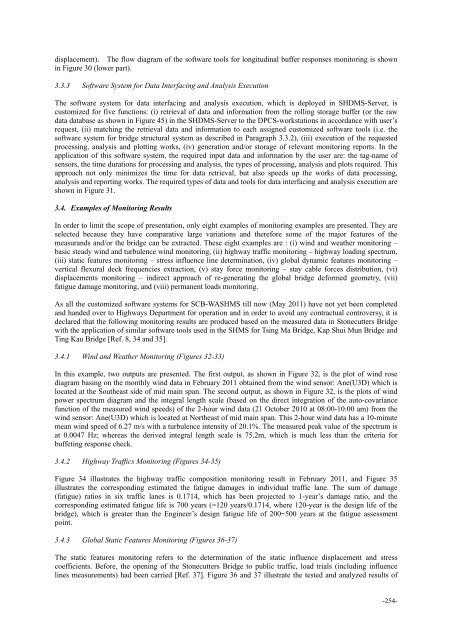r - The Hong Kong Polytechnic University
r - The Hong Kong Polytechnic University
r - The Hong Kong Polytechnic University
You also want an ePaper? Increase the reach of your titles
YUMPU automatically turns print PDFs into web optimized ePapers that Google loves.
displacement). <strong>The</strong> flow diagram of the software tools for longitudinal buffer responses monitoring is shown<br />
in Figure 30 (lower part).<br />
3.3.3 Software System for Data Interfacing and Analysis Execution<br />
<strong>The</strong> software system for data interfacing and analysis execution, which is deployed in SHDMS-Server, is<br />
customized for five functions: (i) retrieval of data and information from the rolling storage buffer (or the raw<br />
data database as shown in Figure 45) in the SHDMS-Server to the DPCS-workstations in accordance with user’s<br />
request, (ii) matching the retrieval data and information to each assigned customized software tools (i.e. the<br />
software system for bridge structural system as described in Paragraph 3.3.2), (iii) execution of the requested<br />
processing, analysis and plotting works, (iv) generation and/or storage of relevant monitoring reports. In the<br />
application of this software system, the required input data and information by the user are: the tag-name of<br />
sensors, the time durations for processing and analysis, the types of processing, analysis and plots required. This<br />
approach not only minimizes the time for data retrieval, but also speeds up the works of data processing,<br />
analysis and reporting works. <strong>The</strong> required types of data and tools for data interfacing and analysis execution are<br />
shown in Figure 31.<br />
3.4. Examples of Monitoring Results<br />
In order to limit the scope of presentation, only eight examples of monitoring examples are presented. <strong>The</strong>y are<br />
selected because they have comparative large variations and therefore some of the major features of the<br />
measurands and/or the bridge can be extracted. <strong>The</strong>se eight examples are : (i) wind and weather monitoring –<br />
basic steady wind and turbulence wind monitoring, (ii) highway traffic monitoring – highway loading spectrum,<br />
(iii) static features monitoring – stress influence line determination, (iv) global dynamic features monitoring –<br />
vertical flexural deck frequencies extraction, (v) stay force monitoring – stay cable forces distribution, (vi)<br />
displacements monitoring – indirect approach of re-generating the global bridge deformed geometry, (vii)<br />
fatigue damage monitoring, and (viii) permanent loads monitoring.<br />
As all the customized software systems for SCB-WASHMS till now (May 2011) have not yet been completed<br />
and handed over to Highways Department for operation and in order to avoid any contractual controversy, it is<br />
declared that the following monitoring results are produced based on the measured data in Stonecutters Bridge<br />
with the application of similar software tools used in the SHMS for Tsing Ma Bridge, Kap Shui Mun Bridge and<br />
Ting Kau Bridge [Ref. 8, 34 and 35].<br />
3.4.1 Wind and Weather Monitoring (Figures 32-33)<br />
In this example, two outputs are presented. <strong>The</strong> first output, as shown in Figure 32, is the plot of wind rose<br />
diagram basing on the monthly wind data in February 2011 obtained from the wind sensor: Ane(U3D) which is<br />
located at the Southeast side of mid main span. <strong>The</strong> second output, as shown in Figure 32, is the plots of wind<br />
power spectrum diagram and the integral length scale (based on the direct integration of the auto-covariance<br />
function of the measured wind speeds) of the 2-hour wind data (21 October 2010 at 08:00-10:00 am) from the<br />
wind sensor: Ane(U3D) which is located at Northeast of mid main span. This 2-hour wind data has a 10-minute<br />
mean wind speed of 6.27 m/s with a turbulence intensity of 20.1%. <strong>The</strong> measured peak value of the spectrum is<br />
at 0.0047 Hz; whereas the derived integral length scale is 75.2m, which is much less than the criteria for<br />
buffeting response check.<br />
3.4.2 Highway Traffics Monitoring (Figures 34-35)<br />
Figure 34 illustrates the highway traffic composition monitoring result in February 2011, and Figure 35<br />
illustrates the corresponding estimated the fatigue damages in individual traffic lane. <strong>The</strong> sum of damage<br />
(fatigue) ratios in six traffic lanes is 0.1714, which has been projected to 1-year’s damage ratio, and the<br />
corresponding estimated fatigue life is 700 years (=120 years/0.1714, where 120-year is the design life of the<br />
bridge), which is greater than the Engineer’s design fatigue life of 200~500 years at the fatigue assessment<br />
point.<br />
3.4.3 Global Static Features Monitoring (Figures 36-37)<br />
<strong>The</strong> static features monitoring refers to the determination of the static influence displacement and stress<br />
coefficients. Before, the opening of the Stonecutters Bridge to public traffic, load trials (including influence<br />
lines measurements) had been carried [Ref. 37]. Figure 36 and 37 illustrate the tested and analyzed results of<br />
-254-

















